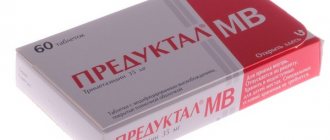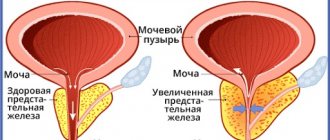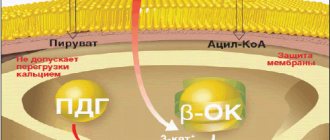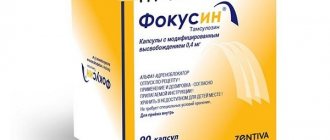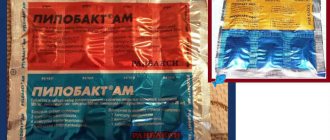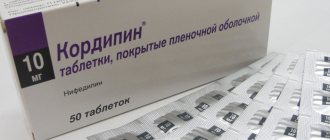Preductal® OD
Mechanism of action
Trimetazidine prevents a decrease in intracellular adenosine triphosphate (ATP) concentration by maintaining the energy metabolism of cells in a state of hypoxia. Thus, the drug ensures the normal functioning of membrane ion channels, transmembrane transport of potassium and sodium ions and the preservation of cellular homeostasis.
Trimetazidine inhibits the oxidation of fatty acids due to the selective inhibition of the enzyme 3-ketoacyl-CoA thiolase (3-CAT) of the mitochondrial long-chain isoform of fatty acids, which leads to increased oxidation of glucose and acceleration of glycolysis with oxidation of glucose, which determines the protection of the myocardium from ischemia. The switch of energy metabolism from fatty acid oxidation to glucose oxidation underlies the pharmacological properties of trimetazidine.
Pharmacodynamic properties:
— supports the energy metabolism of the heart and neurosensory tissues during ischemia;
— reduces the severity of intracellular acidosis and changes in the transmembrane ion flow that occur during ischemia;
- reduces the level of migration and infiltration of polynuclear neutrophils in ischemic and reperfused heart tissues;
- reduces the size of myocardial damage;
- does not have a direct effect on hemodynamic parameters.
In patients with angina, trimetazidine:
— increases coronary reserve, thereby slowing down the onset of ischemia caused by physical activity, starting from the 15th day of therapy;
- limits fluctuations in blood pressure caused by physical activity, without significant changes in heart rate;
- significantly reduces the frequency of angina attacks and the need for short-acting nitroglycerin;
— improves the contractile function of the left ventricle in patients with ischemic dysfunction.
The results of clinical studies have confirmed the effectiveness and safety of trimetazidine in patients with stable angina, both in monotherapy and as part of combination therapy when the effect of other antianginal drugs is insufficient.
In a study of 426 patients with stable angina, the addition of trimetazidine (60 mg/day) to metoprolol 100 mg/day (50 mg twice daily) for 12 weeks statistically significantly improved exercise test scores and clinical symptoms compared with placebo: total duration of exercise tests, total exercise time, time to 1 mm ST segment depression, time to angina attack, number of angina attacks per week, and short-acting nitrate intake per week, without hemodynamic changes.
In a study of 223 patients with stable angina, adding trimetazidine 35 mg twice daily to atenolol 50 mg once daily for 8 weeks increased the time to development of ischemic ST segment depression by 1 mm during exercise tests in a subgroup of patients compared with placebo. A significant difference was also shown for the time of development of angina attacks. There were no significant differences between groups for other secondary endpoints (total exercise test duration, total exercise time, and clinical endpoints).
In a study of 1962 patients with stable angina, trimetazidine (70 mg/day and 140 mg/day) was added to atenolol 50 mg/day compared with placebo. In the general population, including both asymptomatic and symptomatic patients with angina, trimetazidine did not demonstrate benefit on ergometric and clinical endpoints. However, in a retrospective analysis of a subgroup of patients with symptomatic angina, trimetazidine (140 mg) significantly improved total exercise test time and time to onset of angina.
Preductal OD capsules with prolonged release 80 mg 60 pcs. in Bryansk
Trimetazidine prevents a decrease in intracellular adenosine triphosphate (ATP) concentration by maintaining the energy metabolism of cells in a state of hypoxia. Thus, the drug ensures the normal functioning of membrane ion channels, the transmembrane transport of potassium and sodium ions and the preservation of cellular homeostasis.
Trimetazidine inhibits the oxidation of fatty acids due to the selective inhibition of the enzyme 3-ketoacyl-CoA thiolase (3-CAT) of the mitochondrial long-chain isoform of fatty acids, which leads to increased oxidation of glucose and acceleration of glycolysis with oxidation of glucose, which determines the protection of the myocardium from ischemia. The switch of energy metabolism from fatty acid oxidation to glucose oxidation underlies the pharmacological properties of trimetazidine.
Pharmacodynamic properties:
- supports energy metabolism of the heart and neurosensory tissues during ischemia;
- reduces the severity of intracellular acidosis and changes in the transmembrane ion flow that occur during ischemia;
- reduces the level of migration and infiltration of polynuclear neutrophils in ischemic and reperfused heart tissues;
- reduces the size of myocardial damage;
- does not have a direct effect on hemodynamic parameters.
In patients with angina, trimetazidine:
- increases coronary reserve thereby slowing down the onset of exercise-induced ischemia starting from the 15th day of therapy;
- limits fluctuations in blood pressure caused by physical activity without significant changes in heart rate;
- significantly reduces the frequency of angina attacks and the need for short-acting nitroglycerin;
- improves contractile function of the left ventricle in patients with ischemic dysfunction.
The results of clinical studies have confirmed the effectiveness and safety of trimetazidine in patients with stable angina, both in monotherapy and as part of combination therapy when the effect of other antianginal drugs is insufficient.
In a study of 426 patients with stable angina, adding trimetazidine (60 mg/day) to metoprolol 100 mg/day (50 mg twice daily) for 12 weeks statistically significantly improved exercise test scores and clinical symptoms compared with placebo: the total duration of stress tests was +201 s p=0023 total time for performing the load +054 METs p=0001 time until the development of ST segment depression by 1 mm +334 s p=0003 time until the development of an angina attack +339 s p<0001 number of angina attacks per week -073 p=0014 and consumption of short-acting nitrates per week -063 p=0032 without hemodynamic changes.
In a study of 223 patients with stable angina, the addition of trimetazidine 35 mg twice daily to atenolol 50 mg once daily for 8 weeks increased the time to development of ischemic ST segment depression by 1 mm (+344 with p=003) during stress tests in a subgroup of patients (n=173) compared with placebo 12 hours after taking the drug. This difference was also shown for the time of development of angina attacks (p=0049). There were no significant differences between groups for other secondary endpoints (total duration of exercise tests, total exercise time and clinical endpoints).
In a study of 1962 patients with stable angina, trimetazidine at two doses (70 mg/day and 140 mg/day) was added to atenolol 50 mg/day compared with placebo. In the general population, including patients with both asymptomatic and symptomatic angina, trimetazidine did not demonstrate benefit on ergometric (total duration of stress tests, time to onset of ischemic ST-segment depression by 1 mm and time to onset of angina) and clinical endpoints. However, in a post-hoc analysis of a subgroup of patients with symptomatic angina (n=1574), trimetazidine (140 mg) significantly improved total exercise test time (+238 s versus +131 s for placebo; P=.0001) and time to onset of angina ( +463 s versus +325 for placebo; p=0005).
Contraindications
- severe renal failure (creatinine clearance less than 30 ml/min);
- Parkinson's disease, parkinsonian symptoms, tremor, restless legs syndrome and other related movement disorders;
- fructose/sucrose intolerance, glucose-galactose malabsorption syndrome, sucrase/isomaltase deficiency and other enzymopathies associated with intolerance to sucrose included in the drug;
- age under 18 years (due to lack of sufficient clinical data);
- hypersensitivity to any of the components of the drug.
special instructions
Preductal® OD is not intended for the relief of angina attacks and is not indicated for the initial course of treatment of unstable angina or myocardial infarction in the prehospital stage or in the first days of hospitalization.
If an attack of angina occurs, treatment (drug therapy or revascularization procedure) should be reviewed and adapted. Preductal OD can cause or worsen symptoms of parkinsonism (tremor, akinesia, increased tone), so patients should be regularly monitored, especially the elderly. In doubtful cases, the patient should be referred to a neurologist for appropriate examination.
If movement disorders appear, such as symptoms of parkinsonism, restless legs syndrome, tremor, “unsteady” gait, Preductal OD should be permanently discontinued. Such cases are rare and symptoms usually resolve after discontinuation of therapy: in most patients, within 4 months after discontinuation of the drug. If symptoms of parkinsonism persist more than 4 months after discontinuation of the drug, you should consult a neurologist.
There may be cases of falls associated with instability in the Romberg position and “wobbly” gait or a pronounced decrease in blood pressure, especially in patients taking antihypertensive drugs.
The drug contains sucrose, so the drug is not recommended for patients with fructose intolerance, glucose-galactose malabsorption syndrome and sucrase-isomaltase deficiency.
Preductal MV
The drug preductal MB (active ingredient - trimetazidine) belongs to the group of antihypoxants: it improves energy metabolism (primarily the myocardium) and increases the body's resistance to hypoxia. This drug is used mainly in cardiology to treat coronary heart disease and prevent attacks of stable angina, but in some cases it may be in demand in otolaryngology and ophthalmology. Preductal MB is an original drug produced by the pharmaceutical company and its many subsidiaries. The mechanism of its action is realized at the cellular level through a positive effect on ischemic myocardial cells. Preductal MB maintains the intracellular concentration of ATP at the proper level, ensuring the normal operation of ion channels in membranes, the transport of potassium and sodium ions through them, and the constancy of the internal state of the cell. The drug suppresses the oxidation of fatty acids, while simultaneously promoting the oxidation of glucose, which protects the myocardium from the development of ischemia. The transfer of energy metabolism from the oxidation of fatty acids to glycolytic “rails” is, in fact, the main “highlight” of the CF preductal, which underlies its pharmacological action. During clinical trials, a number of positive qualities were observed in the drug. It regulated the energy metabolism of the heart during ischemia, mitigated the consequences of disturbances in the acid-base balance within cells, prevented changes in ion transport through membranes characteristic of ischemia, and reduced the extent of ischemic damage to the myocardium. In patients suffering from angina, preductal MV increases the ability of the coronary vessels to increase blood flow in accordance with the urgent needs of the heart (due to this, the development of ischemia caused by physical activity is inhibited), reduces the amplitude of blood pressure fluctuations provoked by physical activity, without significantly changing the heart rate; reduces the frequency of angina attacks, increases the functional characteristics of the left ventricle.
All these advantages in the pharmacological “summary” of the CF preductal allow us to look with optimism at the outpatient chart of patients suffering from angina pectoris. Preductal MB is produced in tablets with a modified release of the active substance and fully meets the high requirements that are imposed today on modern antianginal drugs, such as: high anti-ischemic effectiveness, maintained thanks to the dosage form throughout the day and a favorable safety profile.
The dosage form of CF preductal should be discussed separately. The active ingredient in the tablet is evenly distributed in methylhydroxypropylcellulose. When it enters the gastrointestinal tract, this hydrophilic matrix swells to form a gel-like substance, which ensures a slow, controlled release of trimetazidine into the blood, and, consequently, stability of the anti-ischemic effect. Thanks to the original dosage form, the effective concentration of the drug in the blood is 31% higher than that of the short-acting dosage form. This is very important, especially in the morning, when the risk of developing acute manifestations of ischemia is highest.
Preductal MB should be taken without chewing and with plenty of water. Dose and frequency of administration: 1 tablet. 2 times a day in the morning and evening during meals. The duration of treatment is determined by the doctor. In conclusion, it should be noted that Preductal CF is not used for the direct relief of angina attacks and is not intended for the initial course of treatment of unstable angina.
